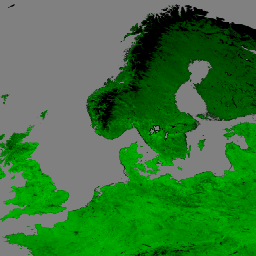
- 利用可能なデータセットの期間
- 2012-01-17T00:00:00Z–2025-11-25T00:00:00Z
- データセット プロバイダ
- USGS EROS センターの NASA LP DAAC
- データ取得頻度
- 8 日間
- タグ
説明
Suomi National Polar-Orbiting Partnership(S-NPP)NASA 可視赤外撮像機放射計(VIIRS)植生指数(VNP13A1)データ プロダクトは、500 メートルの解像度で 16 日間の取得期間に利用可能な最適なピクセルを選択するプロセスによって植生指数を提供します。VNP13 データ プロダクトは、中分解能撮像分光放射計(MODIS)Terra および Aqua 植生指数プロダクト スイートに準拠して設計されており、地球観測システム(EOS)ミッションの継続性を促進します。
VNP13 アルゴリズム プロセスでは、(1) 正規化植生指標(NDVI)、(2) 拡張植生指標(EVI)、(3) 拡張植生指標 2(EVI2)の 3 つの植生指標が生成されます。(1)NDVI は、赤色バンドと近赤外線(NIR)バンドの両方を使用する、最も長い継続的なリモート センシング時系列観測の一つです。(2)EVI は NDVI よりもキャノピー被覆率に敏感な、わずかに異なる植生指数です。NDVI はクロロフィルに敏感です。(3)EVI2 は、赤色バンドと NIR バンドを使用して標準の 3 バンド EVI を再構成したものです。この再編成により、VIIRS EVI を青色バンドを含まない他の EVI モデルと比較する際に発生する問題に対処します。EVI2 は最終的に標準の EVI になります。
このプロダクトには、3 つの植生指数レイヤに加えて、近赤外線(NIR)反射率、3 つの短波赤外線(SWIR)反射率(赤、青、緑の反射率)、合成年日、ピクセルの信頼性、視角と太陽角、品質レイヤのレイヤも含まれています。
詳細については、VIIRS の陸上プロダクト品質評価ウェブサイトにアクセスし、ユーザーガイドをご覧ください。
ドキュメント:
バンド
ピクセルサイズ
500 メートル
バンド
| 名前 | 単位 | ピクセルサイズ | 波長 | 説明 | |||||||||||||||||||||||||||||||||||||||||||||||||||||||||||||||||||||||||||||||||||||||||||||||
|---|---|---|---|---|---|---|---|---|---|---|---|---|---|---|---|---|---|---|---|---|---|---|---|---|---|---|---|---|---|---|---|---|---|---|---|---|---|---|---|---|---|---|---|---|---|---|---|---|---|---|---|---|---|---|---|---|---|---|---|---|---|---|---|---|---|---|---|---|---|---|---|---|---|---|---|---|---|---|---|---|---|---|---|---|---|---|---|---|---|---|---|---|---|---|---|---|---|---|---|
EVI |
メートル | なし | 3 バンドの植生指標 |
||||||||||||||||||||||||||||||||||||||||||||||||||||||||||||||||||||||||||||||||||||||||||||||||
EVI2 |
メートル | なし | 2 バンドのエンハンスト植生指数 |
||||||||||||||||||||||||||||||||||||||||||||||||||||||||||||||||||||||||||||||||||||||||||||||||
NDVI |
メートル | なし | 正規化植生指数 |
||||||||||||||||||||||||||||||||||||||||||||||||||||||||||||||||||||||||||||||||||||||||||||||||
NIR_reflectance |
メートル | 846-885nm | 近赤外線放射の反射率 |
||||||||||||||||||||||||||||||||||||||||||||||||||||||||||||||||||||||||||||||||||||||||||||||||
SWIR1_reflectance |
メートル | 1230 ~ 1250 nm | 短波赤外線放射の反射率 |
||||||||||||||||||||||||||||||||||||||||||||||||||||||||||||||||||||||||||||||||||||||||||||||||
SWIR2_reflectance |
メートル | 1580 ~ 1640 nm | 短波赤外線放射の反射率 |
||||||||||||||||||||||||||||||||||||||||||||||||||||||||||||||||||||||||||||||||||||||||||||||||
SWIR3_reflectance |
メートル | 2225-2275nm | 短波赤外線放射の反射率 |
||||||||||||||||||||||||||||||||||||||||||||||||||||||||||||||||||||||||||||||||||||||||||||||||
VI_Quality |
メートル | なし | 品質評価(QA)ビットフィールド。 |
||||||||||||||||||||||||||||||||||||||||||||||||||||||||||||||||||||||||||||||||||||||||||||||||
red_reflectance |
メートル | 600 ~ 680 nm | 赤色バンドの反射率 |
||||||||||||||||||||||||||||||||||||||||||||||||||||||||||||||||||||||||||||||||||||||||||||||||
green_reflectance |
メートル | 545 ~ 656 nm | 緑色バンドの反射率 |
||||||||||||||||||||||||||||||||||||||||||||||||||||||||||||||||||||||||||||||||||||||||||||||||
blue_reflectance |
メートル | 478 ~ 498 nm | 青色バンドの反射率 |
||||||||||||||||||||||||||||||||||||||||||||||||||||||||||||||||||||||||||||||||||||||||||||||||
composite_day_of_the_year |
d | メートル | なし | ユリウス通日 |
|||||||||||||||||||||||||||||||||||||||||||||||||||||||||||||||||||||||||||||||||||||||||||||||
pixel_reliability |
メートル | なし | シンプルなランククラスを使用したピクセルの有用性 |
||||||||||||||||||||||||||||||||||||||||||||||||||||||||||||||||||||||||||||||||||||||||||||||||
relative_azimuth_angle |
deg | メートル | なし | 各ピクセルの相対方位角 |
|||||||||||||||||||||||||||||||||||||||||||||||||||||||||||||||||||||||||||||||||||||||||||||||
sun_zenith_angle |
deg | メートル | なし | 各ピクセルの太陽天頂角 |
|||||||||||||||||||||||||||||||||||||||||||||||||||||||||||||||||||||||||||||||||||||||||||||||
view_zenith_angle |
deg | メートル | なし | 各ピクセルの天頂角を表示する |
|||||||||||||||||||||||||||||||||||||||||||||||||||||||||||||||||||||||||||||||||||||||||||||||
pixel_reliability クラステーブル
| 値 | 色 | 説明 |
|---|---|---|
| 0 | なし | 非常に良い |
| 1 | なし | 良い |
| 2 | なし | 許可される |
| 3 | なし | Marginal |
| 4 | なし | 合格 |
| 5 | なし | 未確定 |
| 6 | なし | 悪い |
| 7 | なし | 雲の影 |
| 8 | なし | 雪/氷 |
| 9 | なし | Cloud |
| 10 | なし | 概算 |
| 11 | なし | LTAVG(データベースから取得) |
利用規約
利用規約
LP DAAC NASA データは自由にアクセスできますが、著者がこれらのデータやデータに基づく作品を公開する場合は、出版物の本文内でデータセットを引用し、参考文献リストにそれらへの参照を含めることが求められます。
引用
LP DAAC データセットの引用については、LP DAAC の「Citing Our Data」ページを参照してください。
DOI
Earth Engine で探索する
コードエディタ(JavaScript)
var dataset = ee.ImageCollection('NASA/VIIRS/002/VNP13A1') .filter(ee.Filter.date('2017-05-01', '2017-06-30')); var rgb = dataset.select(['EVI']); var rgbVis = { min: 0.0, max: 1.0, palette: ['000000', '004400', '008800', '00bb00', '00ff00'], }; Map.setCenter(17.93, 7.71, 6); Map.addLayer(rgb, rgbVis, 'RGB');
